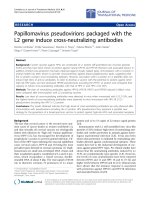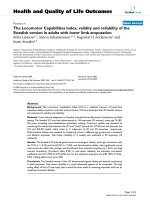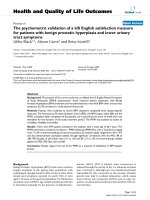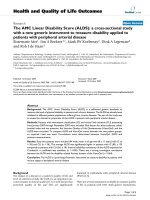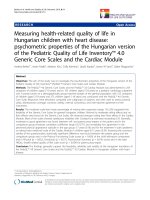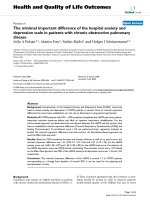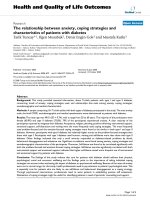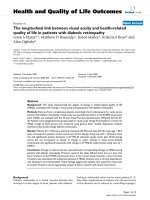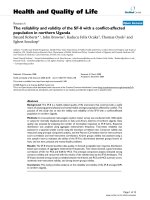Báo cáo hóa học: " The integral estimate with Orlicz norm in L (x)averaging domain" pptx
Bạn đang xem bản rút gọn của tài liệu. Xem và tải ngay bản đầy đủ của tài liệu tại đây (235.74 KB, 7 trang )
RESEARC H Open Access
The integral estimate with Orlicz norm in L
(x)
-
averaging domain
Haiyu Wen
Correspondence:
Department of Mathematics,
Harbin Institute of Technology,
Harbin 150001, PR China
Abstract
In this article, we obtain some local and global integral inequalities with Orlicz norm
for the A-harmonic tensors in L
(x)
-averaging domain, where (x) satisfies the
p
condition. These estimates indicate that many existing inequalities with L
p
-norms are
special cases of our results.
Keywords: A-harmonic equations, differential forms, Luxemburg norms, homotopy
operator
1 Introduction
In recent years, there are many remarkable results about the solutions of the nonho-
mogeneous A-harmonic equation d
⋆
A(x, dω)=B(x, dω) have been made, see [1-7].
For example, in [2], the following Caccioppoli inequality has been established.
du
p
,Q
≤ C|Q|
−1/n
u
p
,σ Q
, p > 1, σ>1
.
(1:1)
In [3] we can find the general Poincaré inequality
u − u
Q
p
,Q
≤ C|Q|diam(Q) du
p
,σ Q
, p > 0, σ>1
.
(1:2)
In [4-6], many inequalities for the classical operators applied to the differential forms
have been studied. These integral inequalities play a crucial role in studying PDE and
the properties of the soluti ons of PDE. However, most of these inequali ties are devel-
oped with the L
p
-norms. Meanwhile, we know the Orlicz spaces is the important tool
in studying PDE, see [8]. So, in this article, the normalized L
p
-norms are replaced by
large norms in the scale of Orlicz spaces. We first introduce the
p
condition, which is
a particular class of the Young functions, then using the result that the maximal opera-
tor M
is bounded on L
p
(ℝ
n
), see [9], we establish some integral estimates with Orlicz
norms. In the global case, we also expand the local results to a relative large class of
domains, the L
-av eraging domain. Applying our results, we can easily find that many
versions of the existing estimates become the special cases of our new results.
Throughout this article, we assume that Ω is a bounded connected open subset of
ℝ
n
, Q,andsQ are the cubes with the same center and diam(sQ)=sdiam(Q), s >0.
We use |E| to denote the Lebesgue measure of the set E ⊂ ℝ
n
.LetΛ
l
= Λ
l
(ℝ
n
)bethe
set of all l-forms on ℝ
n
, D’(Ω, Λ
l
) be the space of all differential l-forms on Ω.Adif-
ferential l-form ω(x) is generated by {dx
i1
∧ dx
i2
∧ ∧ dx
il
}, l =0,1, ,n,thatis
ω(x )=
I
ω
I
(x)dx
I
=
ω
i1,i2, ,il
(x)dx
i1
∧ dx
i2
∧···∧dx
i
l
,whereI =(i
1
, i
2
, , i
l
), 1 ≤ i
1
Wen Journal of Inequalities and Applications 2011, 2011:90
/>© 2011 Wen; licensee Springer. This is an Open Access article distributed under the terms of the Creative Commons Attribution
License ( , which permits unrest ricted use, distribution, and reproduction in any medium,
provided the original work is properly cited.
<i
2
< <i
l
≤ n.LetL
p
(Ω, Λ
l
)bethel-forms
ω(x )=
I
ω
I
(x)dx
I
on Ω satisfying
|ω
I
|
p
< ∞
for all ordered l-tuples I, l =1,2, ,n.Wewrite
||ω||
p,
=
|ω|
p
dx
1/p
=
(
I
|ω
I
(x)|
2
)
p/2
dx
1
/p
.wedenotetheexteriorderivative
by d : D’(Ω, Λ
l
) ® D’(Ω, Λ
l+1
)forl = 0, 1, , n - 1. Its formal adjoint operator d
⋆
:
D’(Ω, Λ
l+1
) ® D’ (Ω, Λ
l
)isgivenbyd
⋆
=(-1)
nl+1
⋆ d⋆ on D’(Ω, Λ
l+1
), l = 0, 1, 2, , n
- 1, here ⋆ is the well known Hodge star operator. A differential l-form u Î D’(Ω, Λ
l
)
is called a closed form if du =0inΩ. A homotopy operator T : C
∞
(Ω, Λ
l
) ® C
∞
(Ω,
Λ
l-1
) is defined in [10], and the decomposition
u
= d
(
Tu
)
+ T
(
du
)
(1:3)
holds for any differential form u. We define the l - form u
Q
Î D’(Q, Λ
l
)by
u
Q
= |Q|
−1
Q
u(y)dy, l =0 and u
Q
= dT(u)
,
(1:4)
for all u Î L
p
(Q, Λ
l
), 1 ≤ p < ∞, then u
Q
= u - T(du), l = 1, 2, , n.
In this article, we consider solutions to the non-homogeneous A-harmonic equation
of the form
d
A
(
x, dω
)
= B
(
x, dω
),
(1:5)
where A : Ω × Λ
l
(ℝ
n
) ® Λ
l
(ℝ
n
) and B : Ω × Λ
l
(ℝ
n
) ® Λ
l-1
(ℝ
n
) satisfy the conditions:
|A(x, ξ)| ≤ a|ξ|
p-1
, 〈A(x, ξ), ξ〉 ≥ | ξ |
p
and |B(x, ξ)| ≤ b|ξ|
p-1
for almost every x Î Ω and
all ξ Î Λ
l
(ℝ
n
). Here, a, b > 0 are constants and 1 <p < ∞ is a fixed exponent associated
with (1.5). A solution to (1.5) is an element of the Sobolev space
W
1
,p
loc
(,
l−1
)
such
that ∫
Ω
〈A(x, dω), d〉 + 〈B(x, dω), 〉 =0forall
ϕ ∈ W
1,p
loc
(,
l−1
)
with compact
support.
2 Main results
In this section, we first obtain the local strong-type Orlicz norm inequality for the
homotopy operator applied to the solutions of Equation 1.5, then, under the similar
method, we establish the Cacciopp oli and Poincaré inequalities with the Orlicz norms.
We also give the generalized weak reverse Hölder-type inequality for the A-h armonic
tensors. Finally, we expand these results to the global case. To prove the main results,
we first introduce the following definitions and lemmas.
Definition 2.1 Given a Young function (t): [0, ∞) ® [0, ∞), and a cube Q,define
the normalized Luxemburg norm on Q by
u
ϕ(Q)
= inf {λ>0:
1
|Q|
Q
ϕ(
|u(x)|
λ
)dx ≤ 1}
.
(2:1)
If (t)=t
p
,1≤ p < ∞,then
u
ϕ(Q)
=(
1
|Q|
Q
|u|
p
dx)
1
p
(see [9]) and the Luxemburg
norm reduce to the L
p
norm.
Given a Young function ,let
¯
ϕ
denote its associate function: the Young function
with the property that
t ≤ ϕ
−1
(
t
)
¯ϕ
−1
(
t
)
≤ 2
t
, t >0.If(t)=t
p
,then
¯ϕ
(
t
)
= t
p
;andif
(t)=t
p
log(e+t)
a
, then
¯ϕ
(
t
)
≈ t
p
log
(
e + t
)
−αp
/
p
, where p’ satisfies
1
p
+
1
p
=
1
.
Wen Journal of Inequalities and Applications 2011, 2011:90
/>Page 2 of 7
Definition 2.2 (see [9]) Given p,1<p < ∞, a Young function sat isfies the
p
con-
dition if for some c >0,
∞
c
ϕ
(
t
)
t
p
d
t
t
< ∞
.
(2:2)
Given a Young function , we define the Orlicz maximal operator associated with
by
M
ϕ
u(x)=sup
Q
x
u
ϕ(Q)
.
(2:3)
We have the following result taken from [9] that characterizes the boundedness of
these maximal functions on L
p
(ℝ
n
). This will play an important role i n the proofs of
our main results.
Lemma 2.3 Given p,1<p < ∞, and a Young function , then for any nonnegative
function f, the following result holds.
M
ϕ
: L
p
(R
n
) → L
p
(R
n
), if and only if ϕ ∈ ϕ
p
.
(2:4)
Lemma 2.4 If A, B, and C are Young functions such that A
-1
(t)B
-1
(t) ≤ C
-1
(t), then for
all functions f and g and any cube Q,
fg
C
(
Q
)
≤ 2 f
A
(
Q
)
g
B
(
Q
)
.
(2:5)
In particular, given any Young function ,
1
|Q|
Q
|f (x)g(x)|dx ≤ 2 f
ϕ(Q)
g
¯ϕ(Q)
.
(2:6)
From [10], we know that, for any differential form
u
∈ L
s
loc
(Q,
l
)
, l = 1, 2, , n,1≤ s
< ∞, we have
||Tu||
s,Q
≤ C|Q|
d
iam
(
Q
)
||u||
s,
Q
(2:7)
and
|
|∇(Tu)||
s,
Q
≤ C|Q|||u||
s,
Q
.
(2:8)
Theorem 2.5. Let (x) be a Young function satisfying
p
condition,1<p < ∞. Assume
ϕ(|u|) ∈ L
1
loc
(
)
and u is a solutio n of the nonhomogeneous equation (1.5) in Ω, T is the
homotopy operator,
ϕ(|Tu|) ∈ L
1
loc
(
)
. Then there exists a constant C, independent of u
such that
|
|Tu||
ϕ
(
Q
)
≤ C|Q|diam(Q)||u||
ϕ
(
σ Q
)
,
(2:9)
where Q is any cube with sQ ⊂ Ω, s is constant with 1<s < ∞.
Proof. Using Hölder inequality with 1 = 1/p +(p -1)/p and the definition of the
Orlicz maximal operator, we have
Tu
ϕ(Q)
≤
1
|Q|
Q
M
ϕ
(|Tu|)dx
≤
1
|Q|
(
Q
(M
ϕ
(|Tu|))
p
dx)
1
p
(
Q
1
p
(p−1)
dx)
(p−1)
p
= |Q|
−1+
(p−1)
p
(
Q
(M
ϕ
(|Tu|))
p
dx)
1
p
.
(2:10)
Wen Journal of Inequalities and Applications 2011, 2011:90
/>Page 3 of 7
Since (x) satisfies the
p
condition, then using Lemma 2.3, we obtain
Tu
ϕ(Q)
≤ C
1
|Q|
−
1
p
Tu
p,Q
.
(2:11)
Applying (2.7), (2.11) becomes
Tu
ϕ(Q)
≤ C
2
|Q|
−
1
p
|Q|diam(Q) u
p,Q
.
(2:12)
u is the solution of Equation 1.5 satisfying the weak reverse Hölder inequality ||u||
s,Q
≤ C||u||
t,sQ
, s > 1 and 0 <s, t < ∞ (see [3]), so
Tu
ϕ(Q)
≤ C
3
|Q|
−
1
p
|Q|diam(Q)|Q|
(1−p)
p
u
1,σ
Q
= C
3
|Q|diam(Q)|Q|
−1
u
1,σ
Q
.
(2:13)
Using Lemma 2.4, we can easily have
Tu
ϕ(Q)
≤ C
4
|Q|diam(Q)|||u|||
ϕ(σ Q)
1
¯ϕ(σ Q
)
≤ C
5
|Q|diam(Q) u
ϕ
(
σ Q
)
.
(2:14)
This ends the proof of Theorem 2.5.
Using the similar method and (2.8), under the same condition of Theorem 2.5 we
can also prove the following result
||∇(Tu)||
ϕ
(
Q
)
≤ C|Q|||u||
ϕ
(
σ Q
)
.
(2:15)
Remark. Using the similar method, we can expand the result to include a variety of
operators-the Green’soperatorG, the projection operator H and other composite
operators such as T ∘ G, T ∘ H, T ∘ Δ ∘ G, and so on.
Using the similar method and the general Caccioppoli inequality (1.1), we can prove
the following Caccioppoli inequality with the Luxemburg norm.
Theorem 2.6 Let (x) be a Young function satisfying
p
condition,1<p < ∞. Assume
ϕ(|u|) ∈ L
1
loc
(
)
and u is a solution of the nonhomogeneous equation (1.5) in Ω,
ϕ(|du|) ∈ L
1
loc
(
)
. Then, there exists a constant C, independent of u such that
du
ϕ
(
Q
)
≤ C|Q|
−
1
n
u
ϕ
(
σ Q
)
,
(2:16)
where Q is any cube with sQ ⊂ Ω, s is constant with 1<s < ∞.
If u is a solution of the equation (1.5), du satisfies the weak reverse Hölder inequality
||du||
p,Q
≤ C||du||
q,sQ
, s >1and0<p, q < ∞(see [3]). So, applying the general Pion-
caré inequality (1.2), under the similar proceeding of Theorem 2.5, we can easily obtain
the following Pioncaré-type inequality.
Theorem 2.7 Let (x) be a Young function satisfying
p
condition,1<p < ∞. Assume
ϕ(|u|) ∈ L
1
loc
(
)
and u is a solution of the nonhomogeneous equation (1.5) in Ω,
ϕ(|du|) ∈ L
1
loc
(
)
. Then, there exists a constant C, independent of u such that
u − u
Q
ϕ
(
Q
)
≤ C|Q|diam(Q) du
ϕ
(
σ Q
)
,
(2:17)
where Q is any cube with sQ ⊂ Ω, s is constant with 1<s < ∞.
We can also generalize the weak reverse Hölder-type inequality for the A-harmonic
tensors.
Wen Journal of Inequalities and Applications 2011, 2011:90
/>Page 4 of 7
Theorem 2.8 Let
1
(x) and
2
(x) be the Young functions with
1
(x) satisfying
p
con-
dition,1<p < ∞. Assume that u is a solution of the nonhomogeneous equation (1.5) in
Ω
ϕ
1
(|u|) ∈ L
1
loc
(
)
and
ϕ
2
(|u|) ∈ L
1
loc
(
)
. Then, there exists a c onstant C, independent
of u such that
u
ϕ
1
(
Q
)
≤
C
u
ϕ
2
(
σ Q
)
,
(2:18)
where Q is any cube with sQ ⊂ Ω, s is constant with 1<s < ∞.
Proof. Using Hölder inequality with 1 = 1/p +(p - 1)/p, we have
u
ϕ
1
(Q)
≤
1
|Q|
Q
M
ϕ
1
(|u|)dx
≤
1
|Q|
Q
(M
ϕ
1
(|u|))
p
dx
1
p
Q
1
p
(p−1)
dx
(p−1)
p
= |Q|
−1+
(p−1)
p
Q
(M
ϕ
1
(|u|))
p
dx
1
p
.
(2:19)
Since
1
(x) satisfies the
p
condition, then using Lemma 2.3, we obtain
u
ϕ
1
(
Q
)
≤ C
1
|Q|
−
1
p
u
p,Q
.
(2:20)
Using the weak reverse Hölder inequality of u, (2.20) becomes
u
ϕ
1
(
Q
)
≤ C
2
|Q|
−
1
p
|Q|
(1−p)
p
u
1,σ Q
.
(2:21)
Using Lemma 2.4, we can easily have
u
ϕ
1
(Q)
≤ C
2
|Q|
−1
||u||
1,σ Q
≤ C
3
|||u|||
ϕ
2
(σ Q)
||1||
¯ϕ
2
(σ Q
)
≤ C
4
||u||
ϕ
2
(
σ Q
)
.
(2:22)
This ends the proof of Theorem 2.8.
In the following L
(x)
-averaging domains, we will extend the local estimates into the
global case.
Definition 2.9 (see [11]). Let (x) be an increasing convex f unction on [0, ∞)with
(0) = 0. we call a proper subdomain Ω ⊂ ℝ
n
an L
(x)
-averaging domain, if |Ω|<∞
and there exists a constant C such that
ϕ(τ |u − u
Q
0
|)dx ≤ C sup
Q
⊂
ϕ(σ |u − u
Q
|)d
x
(2:23)
for some cube Q
0
⊂ Ω and all u such that
ϕ(|u|) ∈ L
1
loc
(
)
,whereτ, s are constants
with 0 <τ < ∞,0<s < ∞. More properties and applications of the L
(x)
-averaging
domain can be founded in [11,12].
Theorem 2.10 Let (x) be a Young function satisfying
p
condition,1<p < ∞, and let
Ω be any bounded L
(x)
-averaging domain. Assume that
ϕ(|du|) ∈ L
1
loc
(
)
and u is a
solution of the nonhomogeneous equation (1.5) in Ω, T is the homotopy operator,
ϕ(|Tu|) ∈ L
1
loc
()
. Then there exists a constant C, independent of u such that
|
|Tu − (Tu)
Q
0
||
ϕ
(
)
≤ C||diam()||u||
ϕ
(
)
,
(2:24)
Wen Journal of Inequalities and Applications 2011, 2011:90
/>Page 5 of 7
where Q
0
⊂ Ω is some fixed cube.
Proof.InL
(x)
-averaging domain, since
ϕ(|Tu|) ∈ L
1
loc
(
)
, Tu satisfies (2.23), so
|
|Tu − (Tu)
Q
0
||
ϕ()
≤ C
1
sup
Q
⊂
||Tu − (Tu)
Q
||
ϕ(Q)
.
(2:25)
For any differential form u, we know that
u
Q
s,
Q
≤ C
2
u
s,
Q
.
(2:26)
Using (2.7) and (2.26), we have
Tu − (Tu)
Q
s,Q
= Td(Tu)
s,Q
≤ C
2
|Q|diam(Q) dTu
s,
Q
= C
2
|Q|diam(Q) u
Q
s,Q
≤ C
3
|Q|diam(Q) u
s,
Q
.
(2:27)
Using the similar method of Theorem 2.5, for s > 1, we can prove
|
|Tu − (Tu)
Q
||
ϕ
(
Q
)
≤ C
4
|Q|diam(Q) u
ϕ
(
σ Q
)
.
(2:28)
Substituting (2.28) in (2.25), we obtain
Tu − (Tu)
Q
0
ϕ()
≤ C
5
sup
Q⊂
|Q|diam(Q) u
ϕ(σ Q
)
≤ C
6
sup
Q⊂
||diam() u
ϕ()
≤ C
7
||diam() u
ϕ
(
)
.
(2:29)
This ends the proof of Theorem 2.10.
Similarly, we can extend Theorem 2.7 into the g lobal case. Under the conditions of
Theorem 2.7, we have
u − u
Q
0
ϕ
(
)
≤ C||diam() du
ϕ
(
)
.
(2:30)
Remark.If(t)=t
p
,then
u
ϕ()
=(
1
|
|
|u|
p
)
1
p
and the Luxemburg norm reduce
to the L
p
norm. Note that a typical Young function that belongs to the class
p
is (t)
= t
s
with 1 ≤ s<p. We can easily increase s ® ∞ as p ® ∞, then for p ≥ 1, our results
can be held with L
p
-norms. So some existing inequalities in [2-5] become the special
cases of our results.
3 Examples
Example 1 We consider the Young function (t) given by
ϕ
1
(t )=
t
p
log
1+δ
(
e + t
)
(3:1)
with δ > 0, which satisfies the
p
conditio n. We defines the L uxemburg norm
u
ϕ
1
()
=inf{λ>0:
1
|
|
ϕ
1
(
|u
(
x
)
|
λ
)dx ≤ 1
}
in the Orlicz space
L
ϕ
1
(
)
.Thereisan
advantage in using the following integral expression instead of
|
|u||
ϕ
1
(
)
Wen Journal of Inequalities and Applications 2011, 2011:90
/>Page 6 of 7
[u]
=
⎛
⎝
1
||
|u(x)|
p
log
1+δ
e +
|u(x)|
u
p,
dx
⎞
⎠
1
p
.
(3:2)
This is not a norm, but compares well with the Luxemburg norm. Using the elemen-
tary inequality
min{1, λ}≤
log(e + λt)
log
(
e + t
)
≤ max{1, λ}
,
(3:3)
we prove
C
1
u
ϕ
1
(
)
≤ [u]
≤ C
2
u
ϕ
1
(
)
.
(3:4)
Under the same conditions of Theorem 2.10, we have
[Tu − (Tu)
Q
0
]
≤ C||diam()[u]
.
(3:5)
Example 2
we can consider another particular example given by
ϕ
2
(t )=
t
p
e
(1+t)
(1−δ)
(3:6)
with 1 <δ <2p, which is continuous, convex and increasing satisfying
2
(0) = 0 and
2
(t) ® ∞ as t ® ∞, so it is a Young function. It also satisfies the
p
condition.
Competing interests
The author declares that the y have no competing interests.
Received: 11 May 2011 Accepted: 24 October 2011 Published: 24 October 2011
References
1. Agarwal, RP, Ding, S: Advances in differential forms and the A-harmonic equations. Math Comput Model. 37, 1393–1426
(2003). doi:10.1016/S0895-7177(03)90049-5
2. Ding, S: Two-weight Caccioppoli inequalities for solutions of nonhomogeneous A-harmonic equations on Riemannian
manifolds. Proc Am Math Soc. 132(8), 2367–2375 (2004). doi:10.1090/S0002-9939-04-07347-2
3. Ding, S, Nolder, CA: Weighted Poincaré inequalities for solutions to A-harmonic equations. Illinois J Math. 46(1),
199–205 (2002)
4. Ding, S, Liu, B: A singular integral of the composite operator. Appl Math Lett. 22, 1271–1275 (2009). doi:10.1016/j.
aml.2009.01.041
5. Xing, B, Ding, S: Norm comparison inequalities for the composite operator. J Inequal Appl (2009). Article ID 212915
6. Xing, Y, Ding, S: Inequlities for Green’s operator with Lipschitz and BMO norms. Comput Math Appl. 58, 273–280 (2009).
doi:10.1016/j.camwa.2009.03.096
7. Wen, H: Weighted norm inequalities for solutions to the nonhomogeneous A-harmonic equation. J Inequal Appl (2009).
Article ID 851236
8. Agarwal, RP, Ding, S: Global Caccioppoli-type and Poincaré inequalities with Orlicz norms. Math Comput Model. 37,
1393–1426 (2003). doi:10.1016/S0895-7177(03)90049-5
9. Pérez, C: On sufficient conditions for the boundedness of the Hardy-Littlewood maximal operator between weighted
L
p
-spaces with different weights. Proc Lond Math Soc. 71 (3), 135–157 (1995)
10. Iwaniec, T, Lutoborski, A: Integral estimates for null Lagrangians. Arch Rational Mech Anal. 125,25–79 (1993).
doi:10.1007/BF00411477
11. Ding, S: L
φ
(μ)-Averaging domains and the quasi-hyperbolic metric. Comput Math Appl. 47(10-11), 1611–1618 (2004).
doi:10.1016/j.camwa.2004.06.016
12. Xing, Y: Poincaré inequalities with Luexmburg norms in L
φ
(m)-averaging domains. J Inequal Appl (2010). Article ID
241759
doi:10.1186/1029-242X-2011-90
Cite this article as: Wen: The integral estimate with Orlicz norm in L
(x)
-averaging domain. Journal of Inequalities
and Applications 2011 2011:90.
Wen Journal of Inequalities and Applications 2011, 2011:90
/>Page 7 of 7
